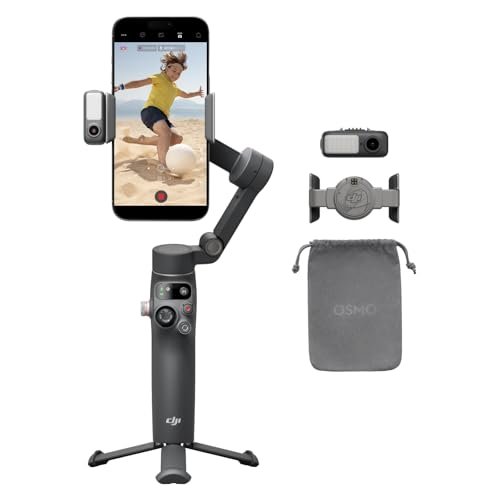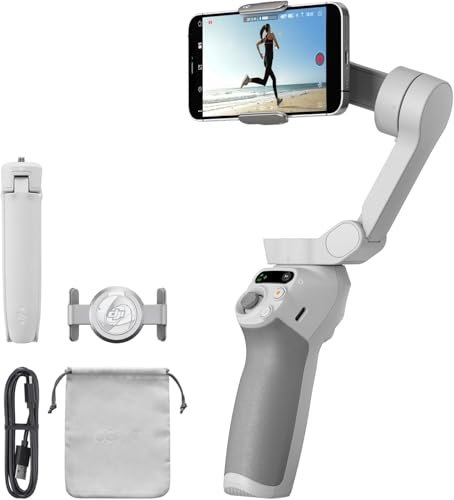So, you’ve got your hands on the powerful Nikon Z6II – a true multimedia powerhouse known for its stunning image quality and impressive video capabilities. But let’s be real, even with its fantastic in-body image stabilization (IBIS), achieving that buttery-smooth, cinematic footage often requires a dedicated companion: a gimbal.
A quality camera gimbal stabilizer can truly transform your handheld video, eliminating shakes and jitters to give your audience a professional, immersive experience. Whether you’re a vlogger, a wedding videographer, or a budding filmmaker, finding the best gimbal for Nikon Z6II is crucial to unlock your camera’s full potential.
But with so many options out there, how do you choose? Don’t sweat it! We’ve scoured the market to bring you our top picks for the best gimbal for Nikon Z6II, ensuring your footage always looks slick and polished. Let’s dive in and find the perfect stabilizer for your Nikon Z6II camera setup!
1. DJI RS 4 3-Axis Gimbal Stabilizer

The DJI RS 4 emerges as a strong contender, often bundled with the Nikon Z6II, signaling its strong compatibility and robust performance for mirrorless cameras. This 3-axis gimbal stabilizer is engineered to provide exceptional video stabilization, allowing your Nikon Z6II to capture incredibly smooth footage, even in dynamic shooting scenarios. Its design focuses on ease of use and efficient operation, making it a reliable tool for both aspiring and seasoned videographers looking to enhance their cinematic output. If you’re serious about smooth camera movement, the RS 4 is definitely worth considering.
Key Features:
– 3-Axis Gimbal Stabilization for professional-grade smooth footage
– Enhanced Vertical Shooting capability for quick transitions to social media-friendly formats
– Designed to handle various camera and lens combinations, including the Nikon Z6II
– Intuitive controls for seamless operation during shoots
Pros:
– Delivers outstanding video stabilization, ideal for the Z6II’s high-resolution video
– The enhanced vertical shooting mode is a game-changer for content creators
– Robust build quality ensures durability and reliability
– Excellent ecosystem and user support from DJI
Cons:
– May be more substantial in size and weight compared to ultra-compact alternatives
– Can have a steeper learning curve for complete beginners
– Some advanced features might require a deeper dive into settings
User Impressions:
Users frequently praise the DJI RS 4 for its reliable performance and solid build. Many highlight the incredibly smooth results it delivers, making even challenging handheld shots look professional. The enhanced vertical shooting is a big hit for those creating content for platforms like TikTok or Instagram Reels.
Call-to-Action: See it on Amazon here
2. DJI RS 3 Mini, 3-Axis Gimbal Stabilizer for Cameras

Don’t let the “Mini” in its name fool you – the DJI RS 3 Mini packs a serious punch when it comes to stabilization for your Nikon Z6II. This ultra-compact and remarkably lightweight gimbal is a dream come true for creators on the go. Weighing in at just 795g (1.75 lbs), it’s incredibly easy to hold for extended shooting sessions, yet boasts a surprising load capacity. It’s perfect for capturing fluid, professional-looking video without the bulk, making it an excellent choice for vloggers, travelers, and anyone who values portability.
Key Features:
– 795g (1.75lbs) Lightweight and Portable design
– Wide-Ranging Compatibility with a load capacity of up to 2 kg (4.4 lbs)
– Bluetooth Shutter Control for automatic camera reconnection and easy photo/video control
– 3rd-Gen RS Stabilization Algorithm for pro-level image stabilization
– Native Vertical Shooting by mounting the quick-release plate to the vertical arm
– 1.4″ Full-Color Touchscreen with an intuitive UI design for easy settings access
Pros:
– Extremely lightweight and portable, ideal for travel and extended use
– Supports a good range of camera and lens combos for its size
– Seamless Bluetooth shutter control enhances workflow
– Excellent stabilization performance for its class
– Dedicated native vertical shooting saves time for social media content
Cons:
– May not accommodate the very heaviest Nikon Z lenses
– Requires the DJI Ronin app for initial activation and full functionality
– The smaller size might mean less room for larger accessories like external monitors
User Impressions:
Many users rave about the RS 3 Mini’s balance of portability and power. They find it incredibly easy to set up and balance, and the native vertical shooting feature is a consistent favorite. The intuitive touchscreen and reliable stabilization make it a top pick for hassle-free, high-quality video.
Call-to-Action: See it on Amazon here
3. ZHIYUN CINEPEER WEEBILL 3E 3-Axis Gimbal Stabilizer for

The ZHIYUN CINEPEER WEEBILL 3E is another strong contender for the best gimbal for Nikon Z6II, offering a compelling blend of portability, power, and user-centric features. This A4-sized gimbal weighs only 1.05 kg (about 2.3 lbs) but can handle up to 3 kg (6.6 lbs) of payload, making it suitable for the Nikon Z6II with a variety of lenses. Its ergonomic design and innovative features are aimed at reducing physical fatigue during long shoots, allowing you to focus purely on nailing those cinematic shots.
Key Features:
– Native Vertical Shooting for quick and efficient posture conversion without extra accessories
– Bluetooth Shutter Control for wireless camera operation
– Built-in 2600mAh batteries with 14W fast charging (2 hours 46 mins charge time)
– 2.5 Sling Mode (requires optional wrist rest and telescopic sling handle) for reduced physical fatigue
– Compact and lightweight (1.05 kg) with a robust 3kg (6.6 lbs) load capacity
– Ergonomic handle design for comfortable, long-term shooting
Pros:
– Excellent load capacity for its size, accommodating many Z6II setups
– Impressive battery life and fast charging minimize downtime
– Ergonomic design helps significantly reduce arm fatigue
– Native vertical shooting is a convenient feature for various platforms
– Wireless camera control via Bluetooth enhances shooting flexibility
Cons:
– Sling mode accessories are not included in the standard package, requiring extra purchase
– Paper-based manuals might be less intuitive for some users compared to app-guided setup
– Cinepeer is a sub-brand; some might prefer the direct Zhiyun branding for support
User Impressions:
Users praise the Weebill 3E for its ergonomic grip and how comfortable it is to use for extended periods. The ability to quickly switch to native vertical shooting is often highlighted as a major benefit. Many appreciate the solid load capacity and the long-lasting battery, making it a reliable companion for full-day shoots.
Call-to-Action: See it on Amazon here
What to Look For in a Gimbal for Your Nikon Z6II
Choosing the best gimbal for Nikon Z6II isn’t just about picking the most popular one. Here are some key factors to consider to ensure you get the perfect match for your needs:
- Load Capacity: This is paramount! Your gimbal must be able to support the combined weight of your Nikon Z6II body, the lens you’ll be using, and any accessories (like a microphone, external monitor, or follow focus system). Always check the gimbal’s maximum payload capacity against your heaviest setup.
- Battery Life: Long shoots require long-lasting batteries. Look for gimbals with decent battery life and ideally, fast-charging capabilities.
- Portability & Weight: Will you be traveling a lot? Hiking with your gear? A lightweight and compact gimbal like the DJI RS 3 Mini might be ideal. If you’re mostly shooting in controlled environments, a slightly heavier but more robust model could work.
- Stabilization Performance: While all gimbals stabilize, some do it better than others. Look for advanced algorithms that provide ultra-smooth, professional results across various movements.
- Ease of Use & Balancing: A gimbal needs to be balanced properly before use. Look for quick-release plates, clear indicators, and intuitive balancing mechanisms to save you time on set. A good touchscreen also helps!
- Connectivity (Bluetooth Shutter Control): Being able to control your Nikon Z6II’s recording start/stop directly from the gimbal saves fumbling with the camera body and makes one-person operations much smoother.
- Vertical Shooting Capability: For social media content creators, native vertical shooting is a huge time-saver, allowing you to shoot portrait-oriented video without re-mounting or complex post-production.
- Accessory Mounts: Consider if you’ll need to mount additional accessories like an external monitor, microphone, or LED light. Extra 1/4″-20 or 3/8″-16 threads, cold shoe mounts, or NATO rails are a plus.
- Ergonomics: For extended shooting sessions, a comfortable grip is essential. Features like sling modes or comfortable handles can drastically reduce fatigue.
Frequently Asked Questions (FAQ)
Q1: Do I really need a gimbal for my Nikon Z6II if it has IBIS?
A1: Yes, absolutely! While the Nikon Z6II’s in-body image stabilization (IBIS) is excellent for stills and helpful for video, a dedicated 3-axis gimbal provides superior stabilization for dynamic camera movements like tracking shots, pans, tilts, and even walking. It eliminates jitters and creates that truly cinematic, floating camera look that IBIS alone can’t achieve.
Q2: What’s the ideal weight capacity I should look for in a gimbal for the Nikon Z6II?
A2: The Nikon Z6II body weighs around 675g (1.49 lbs). Add a lens (e.g., a NIKKOR Z 24-70mm f/4 S is about 500g / 1.1 lbs) and any accessories, and your total setup could easily reach 1.5-2.5 kg (3.3-5.5 lbs). Aim for a gimbal with a minimum load capacity of at least 2 kg (4.4 lbs) to comfortably support your Z6II and common lenses, with more capacity being better for heavier lenses or accessories.
Q3: Can I control my Nikon Z6II from the gimbal?
A3: Many modern gimbals offer camera control features, often via Bluetooth or a control cable. This allows you to start/stop recording, take photos, and sometimes adjust settings directly from the gimbal’s handle or touchscreen. Always check the gimbal’s compatibility list for specific Nikon Z6II functionality.
Q4: How important is Native Vertical Shooting?
A4: Extremely important if you create content for social media platforms like Instagram Reels, TikTok, or YouTube Shorts. Gimbals with native vertical shooting allow you to quickly switch your camera to a portrait orientation without needing to rebalance or use additional accessories, saving significant time during production.
Q5: Are cages necessary when using a gimbal with the Nikon Z6II?
A5: While not strictly necessary for stabilization, a camera cage can be a very useful accessory. It provides protection for your Nikon Z6II and offers multiple mounting points (1/4″-20, ARRI locating pins, cold shoes) for attaching accessories like microphones, monitors, or NATO handles, which can enhance your gimbal setup and overall shooting experience. Many cages also feature Arca-Swiss plates for quick mounting.
Q6: What’s the difference between a 2-axis and a 3-axis gimbal?
A6: A 2-axis gimbal stabilizes on two axes (usually tilt and roll), while a 3-axis gimbal stabilizes on all three axes (tilt, roll, and pan). For serious video work and the best possible stabilization, especially for walking or moving shots, a 3-axis gimbal is always recommended for your Nikon Z6II.
Q7: How do I balance my Nikon Z6II on a gimbal?
A7: Balancing involves adjusting the gimbal’s arms to ensure your camera setup is perfectly centered and doesn’t lean in any direction when powered off. Most gimbals come with quick-release plates and detailed instructions or app tutorials to guide you through the process. Proper balancing is crucial for optimal performance and battery life.
Conclusion
Picking the best gimbal for Nikon Z6II can truly elevate your video production, giving your footage a polished, professional edge that’s hard to achieve with handheld shooting alone. Whether you lean towards the versatility and power of the DJI RS 4, the incredible portability of the DJI RS 3 Mini, or the ergonomic and feature-rich ZHIYUN CINEPEER WEEBILL 3E, any of these choices will be a fantastic addition to your Nikon Z6II setup.
Consider your primary shooting needs – be it travel vlogging, professional filmmaking, or social media content – and match it with the gimbal that best fits your workflow and budget. Happy shooting, and may your footage always be smooth!


